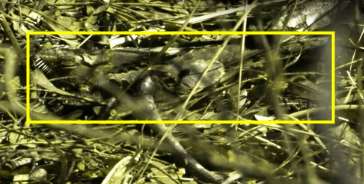The camouflage games: Can you spot the bird?

So how long did it take you to spot the nightjar in the video on this page? For the predators trying to outsmart their concealed prey it's about not going hungry. But for the birds and the eggs that they are protecting it's a matter of life and death. And for scientists interested in how camouflage systems work, letting the public loose on research-oriented games are way to test the fundamental bioscience behind vision and perception.
"Camouflage is extremely important for many animals, but we know relatively little about the underlying mechanisms of how it defeats predator vision and relates to survival, especially in natural systems" says Dr Martin Stevens of the University of Exeter. "There are many concepts and ideas just waiting to be tested."
Stevens has been working on the arms race between animal concealment and the way it attempts to fool the visual systems of predators for more than a decade. His BBSRC-funded Sensory Ecology and Evolution group are currently undertaking ambitious field studies in Africa using advanced hidden cameras (see this 01:30 video trailer for more on this work).
While his colleagues are away in the field, Stevens have been overseeing the development of community-based game studies that ask key questions about how camouflage systems work. Under the banner Project Nightjar, so far his team have released two different games, Where is that nightjar? and Where is that nest? that have been played by more than 15,000 people and provide a valuable and unique data set.
Games that utilise this 'crowdsourcing' approach are increasingly popular. See 'The wisdom of the crowd' for more on how scientists can utilise populations of players in their research.
Hide and seek
"In recent years, we've learnt that camouflage is more complex than people often think," says Stevens. "It's not just a matter of looking like the background – it's way more complex than that."
The fundamentals of camouflage include the classic background matching approach, where an organism attempts to blend in with the surrounding substrate. Then there is disruptive colouration to break up the tell-tale features of body shape, using high contrast markings to achieve their effect. Finally, there are methods of masquerading as a particular object in the background, such as leaves or droppings or even other species.
Camouflage isn't just used for animals quivering in fear for their lives. It has many applications in the real world, even if we are unaware of them much of the time – which at least shows that it's working! Camouflage has a long history of applications in the military, from individual uniforms to the patterning on huge objects such as destroyers. And in the age of satellite surveillance and the use of drones expanding beyond warfare, this is unlikely to stop any time soon.
Another application we are unlikely to notice is the way that mobile phone masts and telegraph poles are starting to be made to look as inconspicuous as possible. The same goes for ugly buildings or ones fenced off for demolition – how much can the boarding merge with the urban situ to hide the destruction behind?
Then there are road signs, which use many of the same principals as camouflage but in reverse so as to look as conspicuous as possible. Lastly, Stevens notes that artists, designers and the fashion industry have long taken an interest in the concept of camouflage, demonstrating its wider interest and applications.
Vanishing point
Stevens says that from the visual perspective of the predator we often don't know much about what mechanisms camouflage strategies use or how they operate in real animals in the wild – the majority of work on camouflage has been undertaken in artificial systems, rather than with real animals out in natural ecosystems. Moreover, further complexities arise when you consider that predators have different visual systems.
Some animals have dichromatic vision, meaning they have cones that detect medium and short wavelengths of light, which might be seen as yellow and blue respectively, such as mongeese. Then there are trichromatic predators such as humans and vervet monkeys that see in red (long wavelength light) in addition to blue and green. Finally, birds can also see in ultraviolet light (UV) in addition to the spectrum of light we see, and likely possess tetrachromatic vision.

To begin to tackle the complexities of how predators see their prey, Stevens' group teamed up with programmer Dave Griffiths who has experience in making educational games. The first game Where is that nightjar? challenges players to spot the bird as quickly as possible. Players can play as a mongoose (dichromatic vision) or as a vervet monkey (trichromatic) and has been played more than 11,000 times.
The second game Where is that egg? also compares dichromatic and trichromatic vision, but there are eggs to find belonging to different bird species, such as crowned plovers and bronze-winged coursers. This way, the researchers will be able to analyse specific patterns and contrasts of colouration to see what is successful under each vision condition. (Griffiths' camouflage page on his blog is recommended for more detail on the games' nuances.)
Data from the second experiment can take the analysis a step further. Because the researchers out in the field have complied data on the eggs' survival in certain nests while participants have been playing the game, Steven's says they can link the two. "One of main aims is to analyse egg detection times by humans under relatively controlled conditions, and then to link that to the predicted level of camouflage based on our image analyses and also how well the nests fared in the field against real predators."
Using this method, the team will have a way of testing whether their models of predator vision tally with human experience in hunting the eggs in terms of detection times, and how that compares to the real survival of the eggs in nature. If the eggs in the field with the longest detection times (best camouflaged) fair best in the field, it would mean that their reconstructions of how animals see are homing in on the key factors.
"The games are a valuable way to do science and get substantial data," says Stevens, although he adds that there are limitations. "You can't use them to replace the study of real animals in the wild, but you can use them to understand key concepts and theory."
To this end a new game is being designed that incorporates elements of natural selection. In this game, populations of eggs will evolve and change in different background environments; this should further help the researchers home in on aspects – shape size, shape distribution, contrast and colour – that determine what makes effective camouflage against different background types.

No hiding in the field
Inspiration for the nightjar project came from Stevens' co-principal investigator on the project Dr Claire Spottiswoode from the University of Cambridge, who realised that the abundance of nightjar nests in field sites she had worked on for other studies might be an ideal model system to test concealment concepts.
"Nests by definition are in a fixed location, so you know the bird has chosen that spot rather than happening to have landed there after being disturbed," she says. "Nightjars also don't build any kind of nest structure but just lay their eggs directly on the natural background, which is important too because it means they depend completely on the appearance of their eggs or their own bodies for concealment."
Finally, she says Zambia is relatively unspoilt and the current range of natural predators is probably similar to what nightjars have had to contend with over the course of evolution.
Spottiswoode filmed the nightjar zoom-in sequences in the video on this page. In fact, the birds are so well camouflaged that she needed a hand herself in finding the nests. "These were all found by a fantastic team of local Zambian nest-finding assistants whom I've worked with for the last eight years," she says. "They're amazing field ornithologists and extremely good at spotting nests of the various species we work on at my field site."

Spottiswoode has been joined in the field by researcher Dr Jolyon Troscianko and research assistant Jared Wilson-Aggarwal, both of the University of Exeter who have taken all the pictures used in the online games.
Together the field studies and computer games hope to answer key questions about how camouflage really works. What types of camouflage work in different habitat types? How does the degree of camouflage affect the probability of being eaten? Does camouflage relate to bird behaviour, such as using behavioural choices to improve concealment?
"Camouflage is a neat example of a beautiful adaptation that we all think we understand, but – as Martin's previous work has shown – when you start to take it to pieces, it turns out to be surprisingly little-understood in natural settings. The eggs of ground-nesting birds lend themselves very well to helping resolve this," says Spottiswoode.
A longer video feature will appear here on the BBSRC News pages and YouTube channel in the coming weeks exploring more of the researchers' experiences in the field and the laboratory modelling techniques they use to simulate animal vision.
BOX: 'The wisdom of the crowd'
Various games and applications have appeared in the last decade that combine computer and human power to solve scientific problems. And as people increasingly engage with games as an acceptable leisure activity, and on mobile devices, this particular 'citizen science' trend looks set to continue.

Moving on from the SETI screensaver that used a computer's idle time (when you're away making a cup of tea) to crunch information to search for extra-terrestrial signals, next-generation applications use real scientific data and turn it into a game, the results feeding back to the scientists who use it for further analyses.
In 2013 BBSRC-funded researchers developed a game called Fraxinus which is hosted on Facebook where it also has a community page. The game presents players with real reference DNA sequences from the ash tree genome. Players are challenged to match up multiple DNA sequence reads from other samples against the references, making as close a match as possible, by shifting base pairs of DNA. Ultimately these differences could reveal regions of the genome that confer useful characteristics such as resistance, which could be bred into a new disease-resistant variety of ash tree to repopulate the UK. In four months after the game was released it received 51057 total visits, with 52% being return players.
Other examples include Fold.it, a puzzle game about protein structures and how to target them with drugs. The portal Zooniverse contains myriad scientific projects where many small efforts from a sufficiently large crowd can outpace the efforts of a single computer. Papers have been published which demonstrate the effect works, such as for the game Phylo.





















